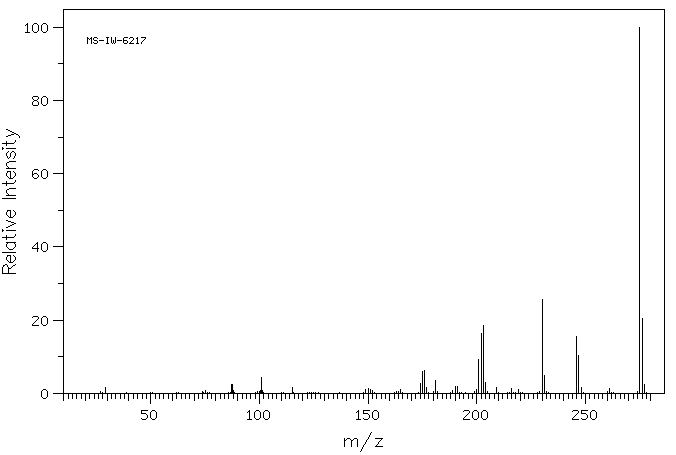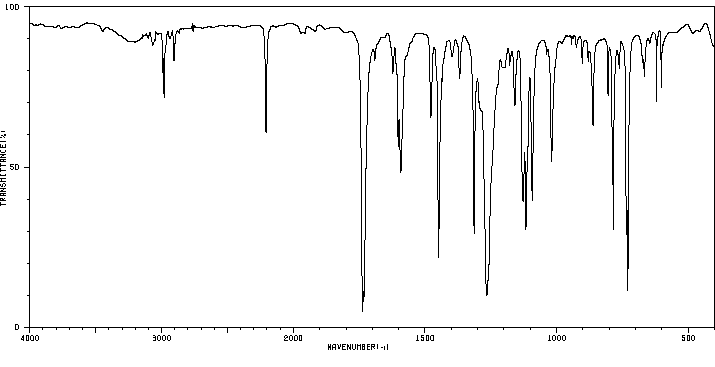ethyl 2-cyano-2-(9H-fluoren-9-ylidene)acetate | 14003-25-9
中文名称
——
中文别名
——
英文名称
ethyl 2-cyano-2-(9H-fluoren-9-ylidene)acetate
英文别名
ethyl α-cyano-9-fluorenylideneacetate;cyano-fluoren-9-yliden-acetic acid ethyl ester;Cyan-fluoren-9-yliden-essigsaeure-aethylester;ethyl 2-cyano-2-fluoren-9-ylideneacetate
CAS
14003-25-9
化学式
C18H13NO2
mdl
——
分子量
275.307
InChiKey
BROYGLVZDTZJAQ-UHFFFAOYSA-N
BEILSTEIN
——
EINECS
——
-
物化性质
-
计算性质
-
ADMET
-
安全信息
-
SDS
-
制备方法与用途
-
上下游信息
-
文献信息
-
表征谱图
-
同类化合物
-
相关功能分类
-
相关结构分类
计算性质
-
辛醇/水分配系数(LogP):3.4
-
重原子数:21
-
可旋转键数:3
-
环数:3.0
-
sp3杂化的碳原子比例:0.11
-
拓扑面积:50.1
-
氢给体数:0
-
氢受体数:3
SDS
上下游信息
-
下游产品
中文名称 英文名称 CAS号 化学式 分子量 —— 2-(9H-fluoren-9-ylidene)acetonitrile 4425-74-5 C15H9N 203.243
反应信息
-
作为反应物:描述:ethyl 2-cyano-2-(9H-fluoren-9-ylidene)acetate 在 盐酸 、 溶剂黄146 作用下, 以 乙醇 、 水 为溶剂, 反应 144.0h, 生成 (9-羧基-芴-9-基)-乙酸参考文献:名称:Borenstein, Michael R.; Abou-Gharbia, Magid A.; Doukas, Peter H., Heterocycles, 1984, vol. 22, # 11, p. 2433 - 2438摘要:DOI:
-
作为产物:参考文献:名称:乙腈中作为氢化物,氢原子和电子受体的各种极性烯烃的热力学亲和力的测定摘要:合成了一系列具有各种典型结构(X)的69种极性烯烃,并获得了氢化物阴离子,氢原子和电子的极性烯烃的热力学亲和力(以摩尔焓变或标准氧化还原电势定义)。利用滴定热法和电化学法测定了极性烯烃(X •–)的质子和氢原子的自由基阴离子的热力学亲和力和极性烯烃(XH •)的电子在乙腈中的电子的热力学亲和力。方法。极性烯烃的纯C═Cπ键杂化和均解离能(X)和乙腈中极性烯烃(X •–)的自由基阴离子的纯C═Cπ键均解离能。使用Hammett线性自由能关系研究了远程取代基对极性烯烃及其相关反应中间体的六个热力学亲和力的影响;结果表明,哈米特线性自由能关系在六个化学和电化学过程中均成立。这项工作中公开的信息不仅可以弥补烯烃作为一类非常重要的有机不饱和化合物的化学热力学的空白,而且可以极大地促进烯烃化学和应用的快速发展。DOI:10.1021/jo4010926
-
作为试剂:描述:(E)-3-甲酰基丁-2-烯基乙酸酯 、 [(2E,4E)-3-甲基-5-(2,6,6-三甲基-1-环己烯-1-基)-2,4-戊二乙烯]三苯基氯化膦 在 ethyl 2-cyano-2-(9H-fluoren-9-ylidene)acetate 作用下, 以 N,N-二甲基甲酰胺 为溶剂, 以40%的产率得到(11Ξ)-O-acetyl-retinol参考文献:名称:Mehta, Raj R.; Pardini, Vera L.; Utley, James H. P., Journal of the Chemical Society. Perkin transactions I, 1982, # 12, p. 2921 - 2926摘要:DOI:
文献信息
-
Polysiloxane-Supported NAD(P)H Model 1-Benzyl-1,4-dihydronicotinamide: Synthesis and Application in the Reduction of Activated Olefins作者:Baolian Zhang、Xiao-Qing Zhu、Jin-Yong Lu、Jiaqi He、Peng G. Wang、Jin-Pei ChengDOI:10.1021/jo020319x日期:2003.4.1A new polysiloxane-supported NAD(P)H model, 1-benzyl-1,4-dihydronicotinamide, was designed and synthesized, which can efficiently reduce many activated olefins under mild conditions. The most advantageous features of this new polysiloxane-supported reductant are (i) easy workup and separation of the reaction products and (ii) good potential for recycling use of the reductant, which makes this new
-
Measurement of pK a values for phosphonium salts via the kinetics of proton transfer to an electrogenerated base作者:Sim Ling-Chung、Keith D. Sales、James H. P. UtleyDOI:10.1039/c39900000662日期:——pKa values have for the first time been measured for common phosphonium ions, including butyl-, allyl-, prop-2-ynyl- and benzyl-triphenylphosphonium, by comparison through a linear Brønsted plot of their rates of proton transfer to an electrogenerated base with those involving carbon acids of known acidity.通过对质子转移至电生成速率的线性布朗斯台德曲线进行比较,首次测量了常见的离子(包括丁基,烯丙基,丙-2-炔基和苄基三苯基phosph)的p K a值含已知酸度的碳酸的碱。
-
Novel Process for the Synthesis of Class I Antiarrhythmic Agent (±)-Cibenzoline and Its Analogs作者:Atul R. Gholap、Vincent Paul、Kumar V. SrinivasanDOI:10.1080/00397910802006388日期:2008.8.18Abstract Synthesis of (±)-cibenzoline and its analogs has been achieved by a simple sequence of reactions. The diaryl cyanoolefin intermediate 3 could be prepared by Knoevenagel condensation of benzophenone with ethylcyanoacetate to form the tetra-substituted olefin intermediate 2 followed by Krapcho deethoxycarbonylation or from β-hydroxynitrile intermediate 2′ followed by the elimination of hydroxyl
-
A hydride transfer reaction from salts of carbanions to activated olefins作者:Ben-Ami Feit、Sarit Shapira、Amatzya HerbstDOI:10.1016/0040-4020(94)00949-u日期:1995.1A novel reaction - a β-elimination of a hydride ion from carbanion salts RM (R = Li, MgBr) and R2N−Li+, and its transfer to tetra-substituted activated olefins of the type Ar2C=C(CN)CO2R (R=Me,Et), was studied. Yields of the reduced H−-acceptor were used to follow the extent of the H−-transfer reaction. A competing Michael addition reaction of RM to the activated olefin also took place. The effects一种新的反应-从碳负离子盐RM(R = Li,MgBr)和R 2 N - Li +中消除氢离子,并将其转移到Ar 2 C = C(CN)型四取代的活化烯烃中研究了)CO 2 R(R = Me,Et)。减小的H的产量-端受体被用来按照H的程度- -转移反应。RM与活化烯烃的竞争性迈克尔加成反应也发生了。溶剂,反应温度,正抗衡离子和的,将H的各种结构特征的溶剂化性能的影响-端供体和H --受体,进行了研究。由于反应的双分子性,与两种反应物有关的结构因素起着至关重要的作用。在RM,次甲基型β碳,或RM的R的小尺寸的Çβ甲苄基取代基,导致在H的相对高的程度- -转移反应。这表明,目前研究的氢离子的β-消除作用是通过双分子E 2 cB型机制产生的。
-
New Reaction of Fullerene C60 with Cyanoacrylates and Ethylmagnesium Bromide in the Presence of Titanium(IV) Isopropoxide作者:Airat Tuktarov、Zulfiya Shakirova、Artur Khuzin、Usein DzhemilevDOI:10.1055/s-0035-1560498日期:——Abstract The reaction of fullerene C60 with cyanoacrylates and ethylmagnesium bromide in the presence of stoichiometric amounts of titanium(IV) isopropoxide was studied for the first time. Under the developed conditions, cyanoacrylates, unlike carboxylic acid esters and nitriles, were found to react with C60 to form aminofullerocyclopropanes, which are otherwise difficult to access. The reaction of fullerene
表征谱图
-
氢谱1HNMR
-
质谱MS
-
碳谱13CNMR
-
红外IR
-
拉曼Raman
-
峰位数据
-
峰位匹配
-
表征信息
同类化合物
(S)-2-N-Fmoc-氨基甲基吡咯烷盐酸盐
(2S,4S)-Fmoc-4-三氟甲基吡咯烷-2-羧酸
黎芦碱
鳥胺酸
魏因勒卜链接剂
雷迪帕韦二丙酮合物
雷迪帕韦中间体6
雷迪帕韦
雷迪帕维中间体
雷迪帕维中间体
雷尼托林
锰(2+)二{[乙酰基(9H-芴-2-基)氨基]氧烷负离子}
醋酸丁酸纤维素
达托霉素杂质
赖氨酸杂质4
试剂9,9-Dioctyl-9H-fluoren-2-amine
螺[环戊烷-1,9'-芴]
螺[环庚烷-1,9'-芴]
螺[环己烷-1,9'-芴]
螺[3.3]庚烷-2,6-二-(2',2'',7',7''-四碘螺芴)
螺-(金刚烷-2,9'-芴)
螺(环己烷-1,9'-芴)-3-酮
藜芦托素
荧蒽 反式-2,3-二氢二醇
草甘膦-FMOC
英地卡胺
苯芴醇杂质A
苯甲酸-(芴-9-基-苯基-甲基酯)
苯甲酸-(9-苯基-芴-9-基酯)
苯并[b]芴铯盐
苯并[a]芴酮
苯基芴胺
苯基(9-苯基-9-芴基)甲醇
苯(甲)醛,9H-芴-9-亚基腙
苯(甲)醛,4-羟基-3-甲氧基-,(3-甲基-9H-茚并[2,1-c]吡啶-9-亚基)腙
芴甲氧羰酰胺
芴甲氧羰酰基高苯丙氨酸
芴甲氧羰酰基肌氨酸
芴甲氧羰酰基环己基甘氨酸
芴甲氧羰酰基正亮氨酸
芴甲氧羰酰基D-环己基甘氨酸
芴甲氧羰酰基D-Β环己基丙氨酸
芴甲氧羰酰基-O-三苯甲基丝氨酸
芴甲氧羰酰基-D-正亮氨酸
芴甲氧羰酰基-6-氨基己酸
芴甲氧羰基-高丝氨酸内酯
芴甲氧羰基-缬氨酸-1-13C
芴甲氧羰基-叔丁基二甲基硅-D-丝氨酸
芴甲氧羰基-beta-赖氨酰酸(叔丁氧羰基)
芴甲氧羰基-S-叔丁基-L-半胱氨酸五氟苯基脂








